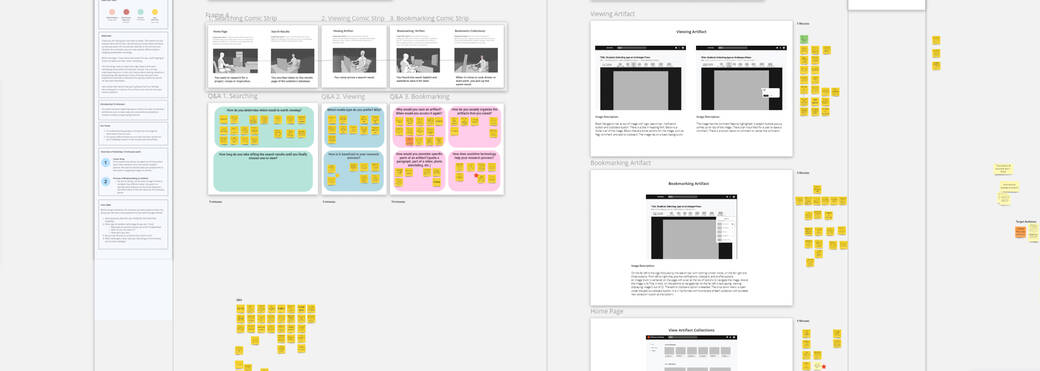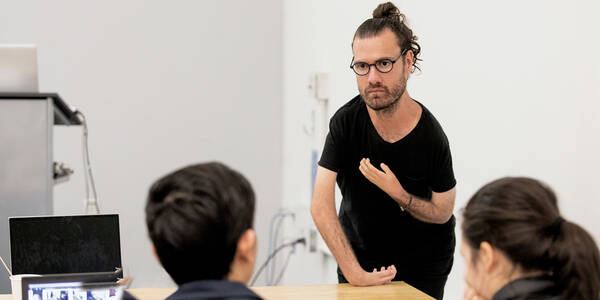
profile / alumni / students / internships / interaction-design / diversity
By Solvej Schou
Charlene Joy Dela Cruz brings her UX skills to NASA’s JPL
Alum puts her Interaction Design bachelor’s degree to use as an intern-turned-UX designer
It’s a bright, breezy day, and alum Charlene Joy Dela Cruz (BS 21 Interaction Design) winds her way down a steep hiking trail lined with cacti and yellow flowers, with Pasadena’s massive Jet Propulsion Laboratory (JPL) sprawled out below.
Dela Cruz, a user experience designer at JPL—NASA’s only federally-funded research and development center—began interning there in 2020, as an ArtCenter student. Her internship turned into a job in 2022, after she graduated.
“JPL is its own world,” says Dela Cruz, resting mid-hike. “I never imagined I would be here. The most I thought about space was when I was kid reading about it, painting galaxies and watching sci-fi films like Interstellar. When JPL came into the picture, I thought, ‘That’s cool! Why not?’”
What’s nice about ArtCenter is that you’re exposed to different types of design. Where that’s valuable at JPL is being a generalist, doing many types of design and design process work.
Charlene Joy Dela CruzJPL user experience designer
Interaction Design alum

Dela Cruz currently works on a service design project focused on improving JPL’s Engineering Change Request process—the approval process of when a design needs to be changed—for NASA and the European Space Agency’s jointly proposed Mars Sample Return mission and its Sample Retrieval Lander. According to the mission, the lander would land on Mars, receive samples collected by NASA’s Perseverance rover, and prepare them to be delivered to Earth.
“At ArtCenter, you identify a problem, ideate solutions, prototype, repeat, in 14 weeks,” says Dela Cruz. “At JPL, you do that for years, for long missions. What’s nice about ArtCenter is that you’re exposed to many different types of design, and you jump into what’s handed to you. Where that’s valuable at JPL is being a generalist, doing many types of design and design process work.”
Raised by relatives in a rural village in the Philippines, and then by her parents in San Jose, California, Dela Cruz grew up with her mom, who worked as an IBM technician, and her dad, who built buses and installed satellite dishes for televisions. As a kid, she painted and did crafts. In high school, she did set design, painted backdrops, designed flyers, shirts and more. While studying graphic design at community colleges, she found out about ArtCenter’s Interaction Design program.

At the College, Dela Cruz loved the course Interaction Design 3, in particular its design prompt about improving affordable housing in the United States. She and other students prototyped a website and phone app as a hub of information and mental health resources.
“The class taught me that design is about more than the visuals,” she says. “It’s about problem solving and talking to the people you’re designing for. Affordable housing is a touchy subject, and it hit close to home. I have relatives who deal with it, but I didn’t see it as a struggle until that class. I felt empowered, like I could finally do something about it.”
While working towards her Designmatters Social Innovation minor, she did participatory design workshops and learned about accessible design in the Designmatters studio Reimagining Access: Inclusive Technology Design for Archives and Special Collections.
When another Interaction Design student began interning at JPL, he encouraged her to apply as well. Not only did Dela Cruz excel at her JPL internship, working on systems involved in computer aided engineering tools and internal software, with a focus on visual design, but she balanced it remotely with schoolwork during the height of the COVID-19 pandemic.
After interning at JPL for two years, Dela Cruz became a JPL user experience designer. Since May 2022, she’s had a hybrid schedule, working both remotely and in person (“on Lab,” as JPL employees say), and commutes from Orange County. “There are a lot of smart individuals at JPL, and a lot of our team members are women,” she points out.

In early 2022, Dela Cruz also started teaching UX skills in Pasadena High School's App Academy, a program for future coders and programmers, as part of a collaboration—IxD @ App Academy—with ArtCenter’s Interaction Design department. “My entrance essay to ArtCenter was about education design,’” she says. “The goal was to let students know that UX exists.” The program was funded by the First Congregational Church of Pasadena, Kenneth T. and Eileen L. Norris Foundation, American Honda Motor Co., Inc., and the Rowe and Gayle Giesen Trust.
At JPL, Dela Cruz uses design methodologies that include participatory design workshops, prototyping, card sorting activities—to help categorize information—and heuristic analysis, to understand pain points and the challenges of software, to align with team members, stakeholders and users.
She’s proud of bringing to her job skills from ArtCenter. Those skills include accessible design principles and design prompts she helped develop as an ArtCenter researcher and designer, while working at JPL, after taking the Reimaging Access studio as a student. She’s presented those findings with groups at JPL, to contribute to a new JPL DEIA (Diversity, Equity, Inclusion, Accessibility) strategy.
“I took what I learned from my ArtCenter mentors, developed the project and shared it with JPL, letting them know, ‘This is how we can leverage accessible design,’ she says. “It’s a start small, dream big sort of approach.”





